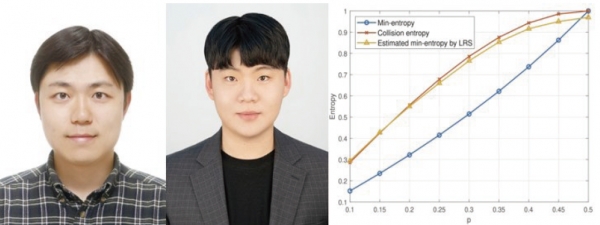
In the information age, constructing security systems for protecting information is an important task. Specifically, computing the randomness of random numbers is crucial because it determines every security system’s safety level. Minimum entropy in the field of information theory is commonly used to quantify the randomness of random numbers.
The joint research team of Professor Yongjune Kim (EEE), Jiheon Woo (EEE Ph.D. Candidate), DGIST Prof. Young-sik Kim, and Technion Prof. Yuval Cassuto successfully developed an algorithm to estimate the minimum entropy accurately, increasing the accuracy of security system assessment. The study was published in the Institute of Electrical and Electronics Engineers (IEEE) Transactions on Information Forensics and Security.
Entropy refers to the uncertainty of an event, and in the field of information security, the minimum entropy is used as an indicator of the safety of security system. The minimum entropy increases as randomly created sequences get harder to predict. So, the random sequence is evaluated as better when it has a higher minimum entropy. Therefore, in order to evaluate the safety of the security system, the minimum entropy must be accurately estimated.
In this study, the research team focused on improving the accuracy of the Longest Repeated Substring (LRS) estimator based on repeated strings. The problem with the National Institute of Standards and Technology (NIST)’s standard estimator is that it overestimates the minimum entropy and judges the safety of the security system higher than its actual security level. The reason is that the LRS estimator always estimates the collision entropy, which is higher than the minimum entropy.
The research team developed a new estimation algorithm to solve this problem. With this, the proposed estimator succeeded in estimating the minimum entropy instead of the inaccurate collision entropy.
Prof. Kim, who led the study, said, "We will try to solve the fundamental problem of the LRS estimator so that this algorithm, which estimates the minimum entropy more accurately, can be adopted as a NIST standard algorithm.”
Meanwhile, this study was conducted with the support of the Institute for Information & Communication Technology Planning & Evaluation (IITP)’s development of highly efficient PQC security and performance verification for constrained devices project and of the National Research Foundation (NRF)’s semantic-aware and task-oriented communications for extremely efficient low-latency 6G project.


